7.6: Wind Energy
- Page ID
- 69432
\( \newcommand{\vecs}[1]{\overset { \scriptstyle \rightharpoonup} {\mathbf{#1}} } \)
\( \newcommand{\vecd}[1]{\overset{-\!-\!\rightharpoonup}{\vphantom{a}\smash {#1}}} \)
\( \newcommand{\dsum}{\displaystyle\sum\limits} \)
\( \newcommand{\dint}{\displaystyle\int\limits} \)
\( \newcommand{\dlim}{\displaystyle\lim\limits} \)
\( \newcommand{\id}{\mathrm{id}}\) \( \newcommand{\Span}{\mathrm{span}}\)
( \newcommand{\kernel}{\mathrm{null}\,}\) \( \newcommand{\range}{\mathrm{range}\,}\)
\( \newcommand{\RealPart}{\mathrm{Re}}\) \( \newcommand{\ImaginaryPart}{\mathrm{Im}}\)
\( \newcommand{\Argument}{\mathrm{Arg}}\) \( \newcommand{\norm}[1]{\| #1 \|}\)
\( \newcommand{\inner}[2]{\langle #1, #2 \rangle}\)
\( \newcommand{\Span}{\mathrm{span}}\)
\( \newcommand{\id}{\mathrm{id}}\)
\( \newcommand{\Span}{\mathrm{span}}\)
\( \newcommand{\kernel}{\mathrm{null}\,}\)
\( \newcommand{\range}{\mathrm{range}\,}\)
\( \newcommand{\RealPart}{\mathrm{Re}}\)
\( \newcommand{\ImaginaryPart}{\mathrm{Im}}\)
\( \newcommand{\Argument}{\mathrm{Arg}}\)
\( \newcommand{\norm}[1]{\| #1 \|}\)
\( \newcommand{\inner}[2]{\langle #1, #2 \rangle}\)
\( \newcommand{\Span}{\mathrm{span}}\) \( \newcommand{\AA}{\unicode[.8,0]{x212B}}\)
\( \newcommand{\vectorA}[1]{\vec{#1}} % arrow\)
\( \newcommand{\vectorAt}[1]{\vec{\text{#1}}} % arrow\)
\( \newcommand{\vectorB}[1]{\overset { \scriptstyle \rightharpoonup} {\mathbf{#1}} } \)
\( \newcommand{\vectorC}[1]{\textbf{#1}} \)
\( \newcommand{\vectorD}[1]{\overrightarrow{#1}} \)
\( \newcommand{\vectorDt}[1]{\overrightarrow{\text{#1}}} \)
\( \newcommand{\vectE}[1]{\overset{-\!-\!\rightharpoonup}{\vphantom{a}\smash{\mathbf {#1}}}} \)
\( \newcommand{\vecs}[1]{\overset { \scriptstyle \rightharpoonup} {\mathbf{#1}} } \)
\( \newcommand{\vecd}[1]{\overset{-\!-\!\rightharpoonup}{\vphantom{a}\smash {#1}}} \)
\(\newcommand{\avec}{\mathbf a}\) \(\newcommand{\bvec}{\mathbf b}\) \(\newcommand{\cvec}{\mathbf c}\) \(\newcommand{\dvec}{\mathbf d}\) \(\newcommand{\dtil}{\widetilde{\mathbf d}}\) \(\newcommand{\evec}{\mathbf e}\) \(\newcommand{\fvec}{\mathbf f}\) \(\newcommand{\nvec}{\mathbf n}\) \(\newcommand{\pvec}{\mathbf p}\) \(\newcommand{\qvec}{\mathbf q}\) \(\newcommand{\svec}{\mathbf s}\) \(\newcommand{\tvec}{\mathbf t}\) \(\newcommand{\uvec}{\mathbf u}\) \(\newcommand{\vvec}{\mathbf v}\) \(\newcommand{\wvec}{\mathbf w}\) \(\newcommand{\xvec}{\mathbf x}\) \(\newcommand{\yvec}{\mathbf y}\) \(\newcommand{\zvec}{\mathbf z}\) \(\newcommand{\rvec}{\mathbf r}\) \(\newcommand{\mvec}{\mathbf m}\) \(\newcommand{\zerovec}{\mathbf 0}\) \(\newcommand{\onevec}{\mathbf 1}\) \(\newcommand{\real}{\mathbb R}\) \(\newcommand{\twovec}[2]{\left[\begin{array}{r}#1 \\ #2 \end{array}\right]}\) \(\newcommand{\ctwovec}[2]{\left[\begin{array}{c}#1 \\ #2 \end{array}\right]}\) \(\newcommand{\threevec}[3]{\left[\begin{array}{r}#1 \\ #2 \\ #3 \end{array}\right]}\) \(\newcommand{\cthreevec}[3]{\left[\begin{array}{c}#1 \\ #2 \\ #3 \end{array}\right]}\) \(\newcommand{\fourvec}[4]{\left[\begin{array}{r}#1 \\ #2 \\ #3 \\ #4 \end{array}\right]}\) \(\newcommand{\cfourvec}[4]{\left[\begin{array}{c}#1 \\ #2 \\ #3 \\ #4 \end{array}\right]}\) \(\newcommand{\fivevec}[5]{\left[\begin{array}{r}#1 \\ #2 \\ #3 \\ #4 \\ #5 \\ \end{array}\right]}\) \(\newcommand{\cfivevec}[5]{\left[\begin{array}{c}#1 \\ #2 \\ #3 \\ #4 \\ #5 \\ \end{array}\right]}\) \(\newcommand{\mattwo}[4]{\left[\begin{array}{rr}#1 \amp #2 \\ #3 \amp #4 \\ \end{array}\right]}\) \(\newcommand{\laspan}[1]{\text{Span}\{#1\}}\) \(\newcommand{\bcal}{\cal B}\) \(\newcommand{\ccal}{\cal C}\) \(\newcommand{\scal}{\cal S}\) \(\newcommand{\wcal}{\cal W}\) \(\newcommand{\ecal}{\cal E}\) \(\newcommand{\coords}[2]{\left\{#1\right\}_{#2}}\) \(\newcommand{\gray}[1]{\color{gray}{#1}}\) \(\newcommand{\lgray}[1]{\color{lightgray}{#1}}\) \(\newcommand{\rank}{\operatorname{rank}}\) \(\newcommand{\row}{\text{Row}}\) \(\newcommand{\col}{\text{Col}}\) \(\renewcommand{\row}{\text{Row}}\) \(\newcommand{\nul}{\text{Nul}}\) \(\newcommand{\var}{\text{Var}}\) \(\newcommand{\corr}{\text{corr}}\) \(\newcommand{\len}[1]{\left|#1\right|}\) \(\newcommand{\bbar}{\overline{\bvec}}\) \(\newcommand{\bhat}{\widehat{\bvec}}\) \(\newcommand{\bperp}{\bvec^\perp}\) \(\newcommand{\xhat}{\widehat{\xvec}}\) \(\newcommand{\vhat}{\widehat{\vvec}}\) \(\newcommand{\uhat}{\widehat{\uvec}}\) \(\newcommand{\what}{\widehat{\wvec}}\) \(\newcommand{\Sighat}{\widehat{\Sigma}}\) \(\newcommand{\lt}{<}\) \(\newcommand{\gt}{>}\) \(\newcommand{\amp}{&}\) \(\definecolor{fillinmathshade}{gray}{0.9}\)Wind energy arises from the motion of the air. It is driven by solar energy (differences in air temperature causes air currents). The wind turns a turbine, which powers a generator (figure \(\PageIndex{1}\)). The rotor blades of a wind turbine work like an airplane wing or helicopter rotor blade. When wind flows across the blade, the air pressure on one side of the blade decreases, and this causes the rotor to spin. The rotor connects to the generator, either directly or through a series of gears that speed up the rotation and allow for a physically smaller generator. Similar to the electricity generation from coal, natural gas, or nuclear energy, the rotating motion causes magnets spin within wire coils to produce electricity. According to the American Wind Energy Association, 39% of all new electrical generating capacity in the United States in 2019 was due to wind.
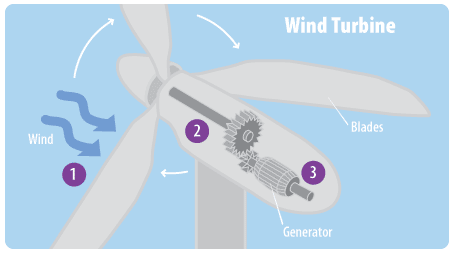
Figure \(\PageIndex{1}\): (1) As the wind blows over the blades of a wind turbine, it causes the blades to lift and rotate. (2) The rotating blades turn a shaft that is connected to a generator. (3) The generator creates electricity as it turns. Image and caption (modified) from EPA (public domain).
Interactive Element
Click here for an interactive animation illustrating how wind turbines work.
Advantages of Wind Energy
Wind is among the lowest-cost sources of renewable energy, and its expansion creates jobs (figure \(\PageIndex{2}\)). Like many renewable energy sources, wind turbines do not release air pollutants or contribute to climate change, and they do not require water for cooling. Because a wind turbine has a small physical footprint relative to the amount of electricity it produces, many wind farms are located on crop and pasture land. They contribute to economic sustainability by providing extra income to farmers and ranchers, allowing them to stay in business and keep their property from being developed for other uses. For example, energy can be produced by installing wind turbines in the Appalachian mountains of the United States instead of engaging in mountain top removal for coal mining. Offshore wind turbines on lakes or the ocean may have smaller environmental impacts than turbines on land, and winds are up to 50% stronger and steadier offshore than on land (figure \(\PageIndex{3}\)).
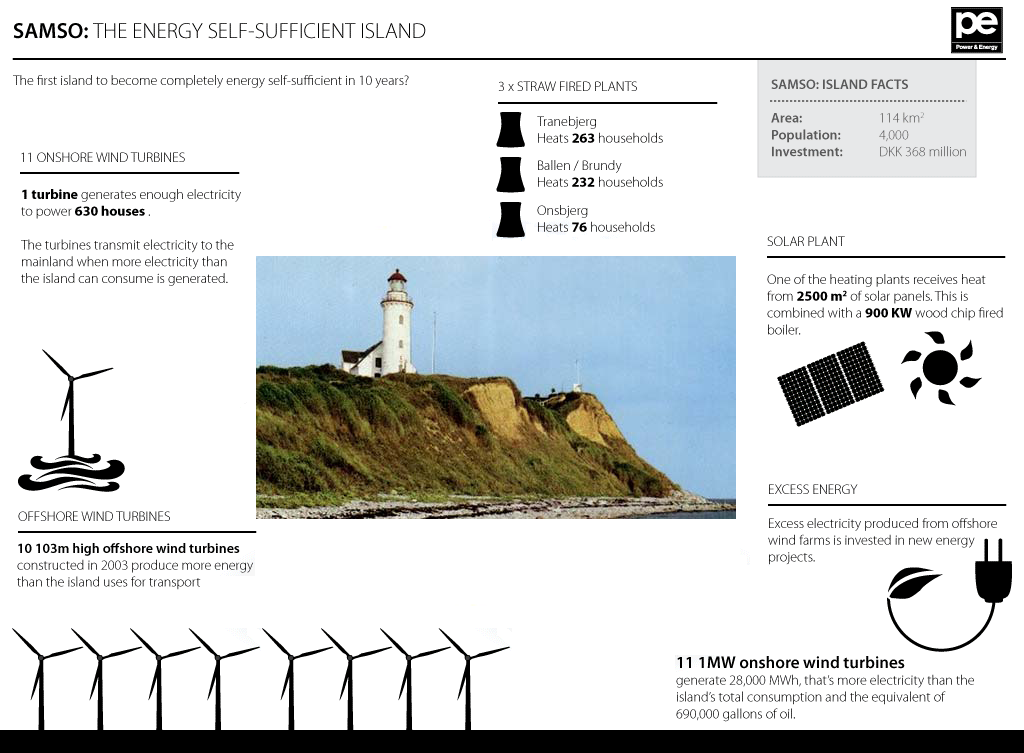
Figure \(\PageIndex{2}\): The Danish island of Samsø was the first region in the country to transition to 100% renewable energy, relying on offshore wind, onshore wind, straw (a biofuel), and solar. The text in the image is, "Samsø : The Energy Self-sufficient Island. The first island to become complete energy self-sufficient in 10 years. Samsø: Island Facts— Area: 114 km2, Population: 4,000, Investment: DKK 368 million. 11 Onshore Wind Turbines— 1 turbine generates enough electricity to power 630 houses. The turbines transmit electricity to the mainland when more electricity than the island can consume is generated. Offshore Wind Turbines- 10 103-m-high offshore wind turbines constructed in 2003 produce more energy than the island uses for transport. 11 1-MW Onshore Wind Turbines generate 28,000 MWh. That's more electricity than the island's total consumption and the equivalent of 690,000 gallons of oil. 3X Straw-fired Plants— Traneberg- heats 263 households, Ballen/Brundy- heats 232 households, Onsbjerg- heats 76 households. Solar Plant- One of the heating plants receives heat from 2500 m2 of solar panels. This is combined with a 900 KW wood chip-fired boiler. Excess Energy- Excess electricity produced from offshore wind farms is invested in new energy projects. Images by GDS Infographics (CC-BY) and National Geospatial-Intelligence Agency (public domain).
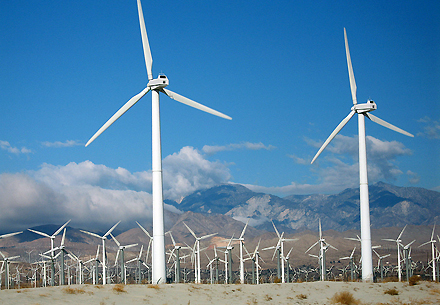
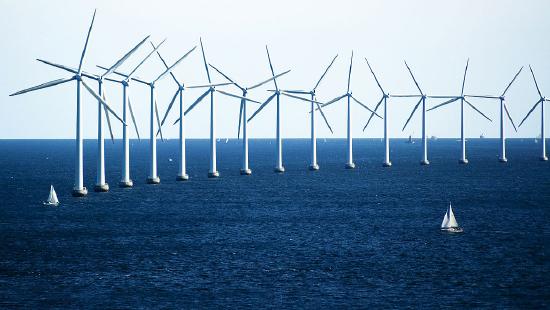
Figure \(\PageIndex{3}\): Wind turbines may be on land (onshore, left) or in the ocean (offshore, right). Left image by Joshua Winchell/USFWS (public domain). Right image by CGP Grey (CC-BY).
Disadvantages of Wind Energy
Wind energy does have a few challenges. Wind turbines are only effective in regions with strong enough winds to generate sufficient electricity. Even in regions with strong winds, wind availability is intermittent. This can be mitigated by the use batteries to store energy, but battery capacity, despite continuous technological advances, is still limited. There are aesthetic concerns to some people when they see them on the landscape, and some people do not like the sound that wind turbine blades make. A few wind turbines have caught on fire, and some have leaked lubricating fluids, though this is relatively rare. Turbines have been found to cause bird and bat deaths particularly if they are located along their migratory path, although communication towers and domestic cats are bigger threats. There are some small impacts from the construction of wind projects or farms, such as the construction of service roads, the production of the turbines themselves, and the concrete for the foundations.
The wind resource of the United States, while abundant, is less homogeneous. Strong winds require steady gradients of temperature and pressure to drive and sustain them, and these are frequently associated with topological features such as mountain ranges or coastlines. The onshore wind map of the United States shows this pattern, with the best wind along a north-south corridor roughly at mid-continent (Figure \(\PageIndex{4}\)). Offshore winds over the Great Lakes and the east and west coasts are stronger and steadier though they cover smaller areas. The technical potential for onshore wind is over 8000 GW of capacity (Lu, 2009; Black & Veatch, 2007) and offshore is 800 – 3000 GW (Lu, 2009; Schwartz, Heimiller, Haymes, & Musial, 2010). For comparison, the United States used electricity in 2009 at the rate of 450 GW averaged over the day-night and summer-winter peaks and valleys.
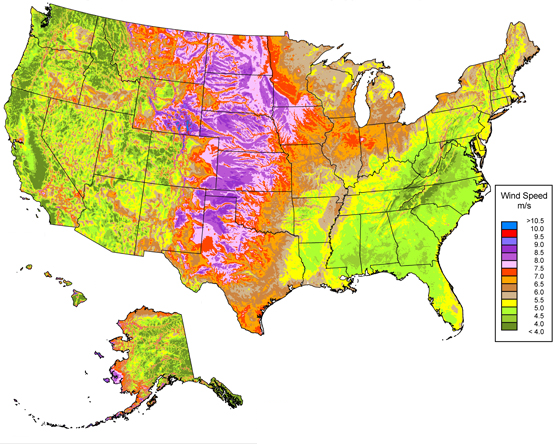
Figure \(\PageIndex{4}\): 80 Meter Wind Resource Map Figure shows the average wind speeds in the United States at 80 meters. Also see offshore wind resource maps. Source: U.S. Department of Energy, National Renewable Energy Laboratory and AWS Truepower LLC
Attribution
Modified by Kyle Whittinghill and Melissa Ha from the following sources:
- Renewable Energy and Challenges and Impacts of Energy Use from Environmental Biology by Matthew R. Fisher (licensed under CC-BY)
- The Power of Wind. Office of Energy Efficiency and Renewable Energy. U.S. Department of Energy. Accessed 01-17-2021 (public domain).
- Renewable Energy: Solar, Wind, Hydro and Biomass in Sustainability a Comprehensive Foundation by Tom Theis and Jonathan Tomkin
- Essentials of Environmental Science by Kamala Doršner is licensed under CC BY 4.0.


